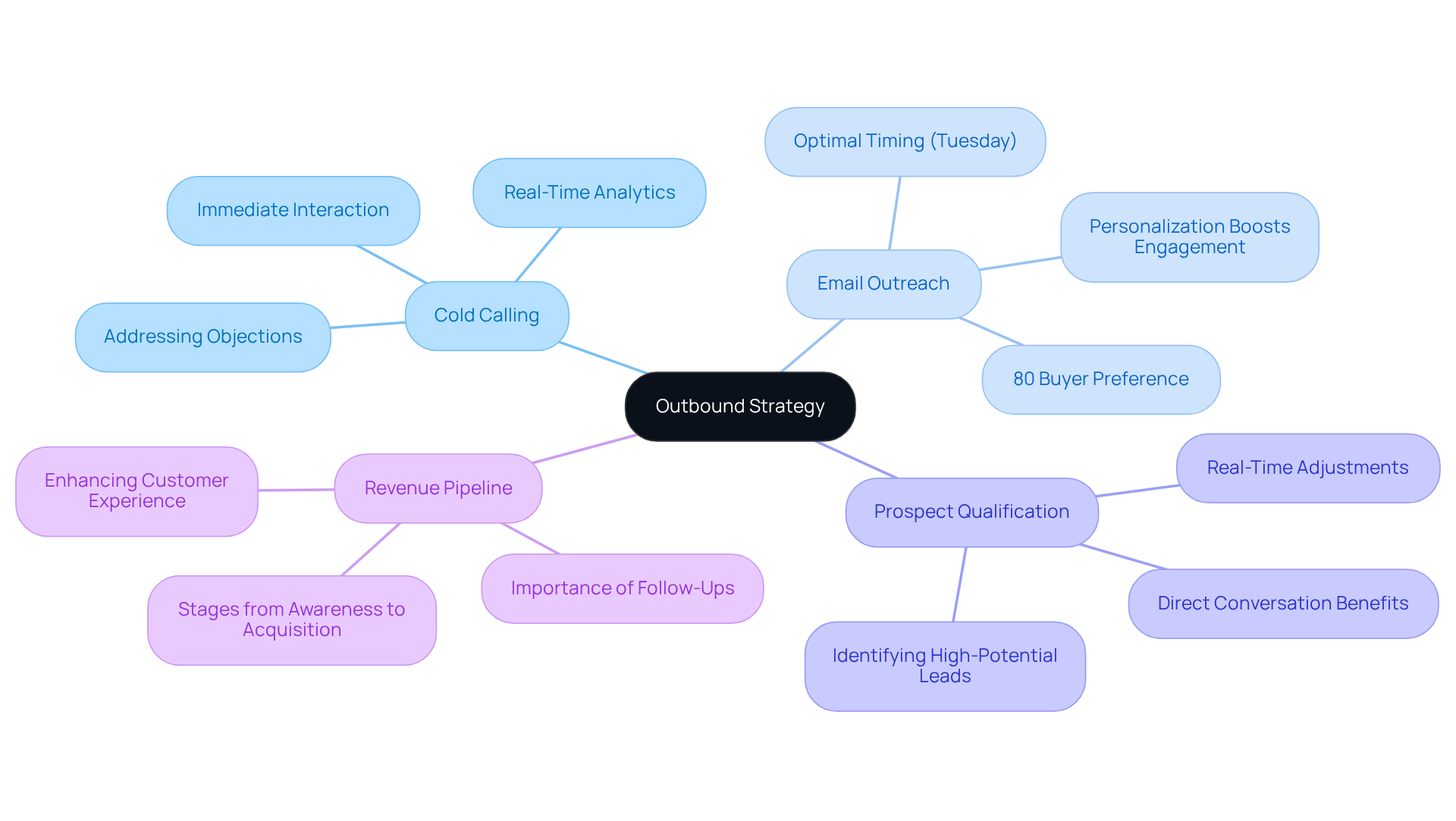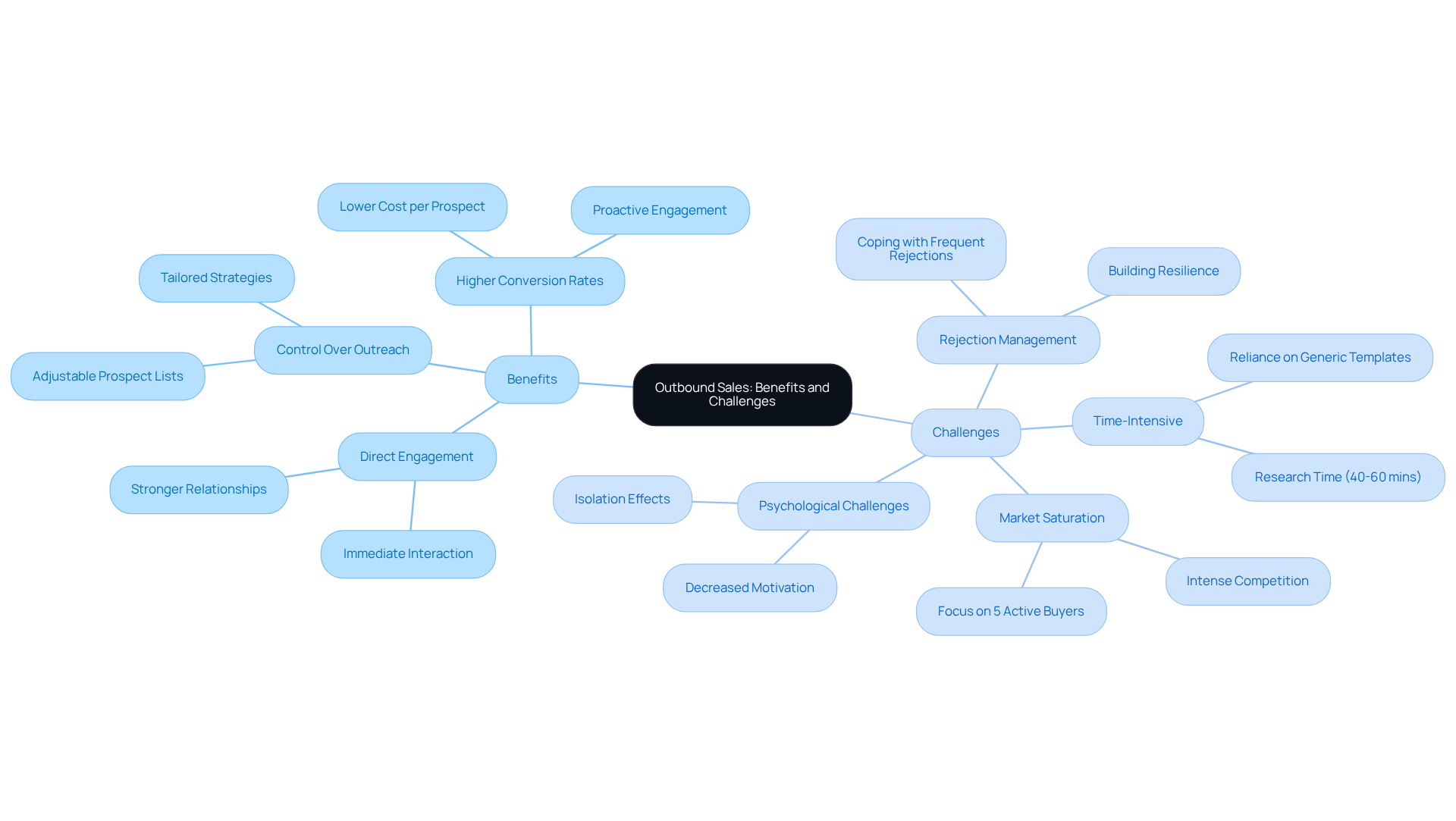Introduction
Understanding outbound sales is crucial for sales managers aiming to elevate their team's performance and drive revenue growth. This proactive approach not only involves reaching out to potential clients but also harnesses innovative technologies like AI to streamline communication and enhance engagement.
However, the landscape of outbound sales presents significant challenges, from managing rejections to navigating market saturation. Sales leaders must effectively harness these strategies and technologies to maximize their outreach efforts and achieve higher conversion rates.
By embracing these insights, sales managers can transform their approach, ensuring their teams are equipped to thrive in a competitive environment.
Define Outbound: Core Concepts and Terminology
The outbound definition illustrates a proactive strategy in which representatives take the initiative to communicate with potential clients rather than waiting for them to show interest. This approach is vital for driving engagement and conversions, particularly when enhanced by Intone's AI voice automation. Key concepts in this field include:
- Cold Calling: This method involves directly reaching out to prospects via phone, facilitating immediate interaction and the chance to address objections in real-time. With Intone's human-like AI voice agents, sales teams can harness advanced technology to close deals more effectively and monitor changes in key metrics within minutes of launching a new script.
- Email Outreach: Sending targeted emails to prospective clients is another effective strategy, especially since 80% of buyers prefer this method of contact. Personalization in email outreach can significantly boost engagement rates, with emails sent on Tuesday achieving 30% higher open rates.
- Prospect Qualification: This process involves assessing which prospects are most likely to convert into customers, ensuring that marketing efforts are focused on high-potential candidates. Qualifying prospects is more straightforward through direct conversation compared to other methods, underscoring the value of cold calling. Intone's real-time analytics empower managers to track key metrics and swiftly adjust strategies, ensuring efforts are concentrated on the most promising leads.
- Revenue Pipeline: Understanding the revenue pipeline is essential, as it outlines the journey prospective clients take from initial awareness to final acquisition. Persistence in follow-ups is crucial, as it helps sustain engagement and enhances the likelihood of conversion. With Intone's automated messaging and integrated features, sales teams can extend discussions and elevate the customer experience, ultimately transforming the sales process.
Mastering these concepts is critical for managers aiming to develop effective strategies and communicate clearly with their teams. Effective cold calling strategies, such as quickly building rapport and providing value before pitching, can significantly impact conversion rates, especially when supported by Intone's innovative solutions.

Explore Outbound Sales Strategies: Techniques for Success
Successful outbound sales strategies hinge on several key techniques that can significantly enhance your results:
-
Targeted Prospecting: Start by identifying and segmenting your ideal customer profiles (ICPs). This focused approach allows sales teams to concentrate their efforts on high-potential prospects, thereby increasing conversion chances. Research shows that a well-defined ICP can lead to a remarkable 50% increase in leads and appointments.
-
Personalized Outreach: Customize your communication to address the specific needs and pain points of each prospect. True personalization transcends generic messaging; it demands thorough research and a genuine reason for outreach. This strategy not only captures attention but also fosters trust, greatly enhancing response rates.
-
Multi-Channel Engagement: Connect with prospects through various channels, including phone calls, emails, and social media. A multi-channel approach can elevate conversion rates by up to 300% compared to single-channel strategies, ensuring your outreach resonates in the environments where prospects feel most comfortable.
-
Follow-Up Cadence: Implement a systematic follow-up process to keep engaging prospects who may not respond initially. Effective prospecting often requires 6 to 10 touches over a span of 7 to 14 days, maintaining warmth without overwhelming leads.
-
Performance Metrics: Regularly assess essential performance indicators (KPIs) such as response frequencies, conversion figures, and sales cycle durations. This data-driven approach empowers commercial teams to continuously refine their strategies, ensuring outreach efforts remain efficient and aligned with market dynamics.
By applying these methods, you can significantly enhance the efficiency of your outbound marketing initiatives, which contributes to a clearer outbound definition and leads to improved conversion rates and overall performance.

Evaluate Benefits and Challenges of Outbound Sales: Insights for Managers
Outbound sales offer significant advantages that can transform your business approach:
- Direct Engagement: This method allows for immediate interaction with potential customers, fostering stronger relationships and building trust.
- Control Over Outreach: Sales teams can dictate the pace and volume of their outreach efforts, enabling tailored strategies that align with business objectives. Outbound transactions provide full control over targeting and pace, allowing teams to adjust prospect lists and contact volumes as necessary.
- Higher Conversion Rates: Proactive engagement often leads to higher conversion rates compared to passive methods. Statistics reveal that outbound transactions can generate prospects at a lower cost than digital marketing, with many organizations reporting that over 51% of their overall pipeline originates from phone calls.
However, challenges remain:
- Rejection Management: Sales representatives must develop resilience to cope with frequent rejections, which can be disheartening. As Tony Horwath noted, "If outbound efforts are executed correctly, it can assist you in pursuing larger clients," underscoring the importance of perseverance in the face of challenges.
- Time-Intensive: Outbound marketing often requires a significant time investment for researching and reaching out to prospects. On average, account research can take 40-60 minutes, leading to reliance on generic templates if not managed effectively.
- Market Saturation: Many industries face intense competition, making it increasingly challenging to stand out. With approximately 95% of target accounts not in an active purchasing window, sales teams must focus on the 5% that show genuine buying signals to enhance outreach effectiveness.
- Psychological Challenges: Remote salespeople frequently encounter psychological hurdles due to isolation, which can diminish motivation and team cohesion. Addressing these challenges is crucial for maintaining a productive commercial environment.
By thoroughly evaluating these factors, managers can better equip their teams to navigate the complexities of outbound transactions and improve overall performance, aligning with the outbound definition.

Leverage Technology: Enhancing Outbound Sales with AI Solutions
To enhance outbound sales, consider leveraging AI solutions such as:
- AI Voice Agents: Intone's AI voice agents automate initial outreach and follow-ups, allowing sales representatives to focus on closing deals. By managing routine tasks, these agents contribute to an outbound definition that enables teams to engage more effectively with high-value prospects. They can significantly boost conversion metrics by automating prospect management and follow-ups, which exemplifies the outbound definition of indispensable resources for any sales team. Furthermore, they can be customized to meet specific business needs, ensuring interactions are tailored according to the outbound definition for optimal customer engagement, including upsell opportunities and re-engaging past buyers.
By utilizing data-driven insights, predictive analytics can pinpoint high-intent prospects, which supports the outbound definition and empowers sales teams to prioritize their outreach efforts. For example, Intone's AI can identify accounts exhibiting buying signals and recommend tailored products based on integrated customer data, significantly improving the outbound definition of engagement. Personalized emails can increase click-through rates by 14%, which underscores the effectiveness of outreach as defined by the outbound definition.
The outbound definition involves implementing systems that seamlessly integrate with existing CRM tools to streamline prospect management and tracking. Intone's AI voice agents can be customized to interact with your CRM, ensuring sales teams have access to up-to-date information, which enhances their outbound definition and ability to respond to opportunities swiftly. AI tools also simplify the assessment of key performance indicators (KPIs) such as conversion metrics and email response rates, which aligns with the outbound definition of fostering continuous improvement in sales strategies.
Automated Reporting: Intone's AI can generate performance reports that provide valuable insights into revenue activities and outcomes, including an outbound definition of these metrics. This capability allows teams to monitor essential performance indicators (KPIs), such as lead conversion percentages and email response rates, which aligns with the outbound definition of promoting ongoing enhancement in marketing tactics.
By adopting these technologies, sales teams can improve their outbound definition, boost efficiency, increase conversion rates, and ultimately drive more revenue. For instance, companies like XYZ Corp. have reported a 25% increase in conversions and a 40% reduction in call handling time after implementing Intone's AI voice agents, which exemplifies the outbound definition of the tangible benefits of these solutions. As Convin states, the outbound definition of AI voice agents is that they help your sales team move faster, work smarter, and reduce bottlenecks.

Conclusion
The proactive approach of outbound sales stands as a pivotal strategy that empowers sales teams to take the initiative in engaging potential clients. By grasping and applying core concepts such as cold calling, email outreach, and effective prospect qualification, sales managers can significantly elevate their team's performance and drive conversions. Moreover, the integration of technology, particularly AI solutions, amplifies these efforts, enabling more personalized and efficient communication with prospects.
Key techniques for successful outbound sales are essential to highlight:
- Targeted prospecting
- Personalized outreach
- The significance of multi-channel engagement
Direct engagement offers benefits, providing control over outreach efforts, yet challenges such as rejection and market saturation persist. By evaluating these factors, managers can better equip their teams to navigate the complexities of outbound sales, ensuring a focused approach that maximizes results.
Ultimately, embracing the definition of outbound sales and its associated strategies is crucial for any organization striving to thrive in a competitive landscape. Leveraging advanced technologies and refining outreach techniques not only improves conversion rates but also fosters stronger relationships with prospects. This proactive mindset is vital for driving business growth and maintaining a competitive edge in the market.
Frequently Asked Questions
What is the definition of outbound in a sales context?
Outbound refers to a proactive strategy where sales representatives initiate communication with potential clients instead of waiting for them to express interest.
What are the key methods used in outbound sales?
The key methods include cold calling, email outreach, and prospect qualification.
What is cold calling and its benefits?
Cold calling involves directly reaching out to prospects via phone, allowing for immediate interaction and the opportunity to address objections in real-time. It is enhanced by Intone's AI voice agents, which help sales teams close deals more effectively.
How does email outreach function in outbound sales?
Email outreach involves sending targeted emails to prospective clients, which is preferred by 80% of buyers. Personalization can significantly increase engagement rates, with emails sent on Tuesdays achieving 30% higher open rates.
What is prospect qualification and why is it important?
Prospect qualification is the process of assessing which prospects are most likely to convert into customers. It ensures marketing efforts focus on high-potential candidates and is more effective through direct conversation, particularly in cold calling.
What is the revenue pipeline and its significance?
The revenue pipeline outlines the journey prospective clients take from initial awareness to final acquisition. Understanding this process is essential for maintaining engagement and increasing conversion likelihood through persistence in follow-ups.
How does Intone's technology enhance outbound strategies?
Intone's AI voice automation and real-time analytics empower sales teams to monitor key metrics, adjust strategies swiftly, and improve customer experience, thus transforming the sales process.
What are effective strategies for cold calling?
Effective cold calling strategies include quickly building rapport with prospects and providing value before making a pitch, which can significantly impact conversion rates.






